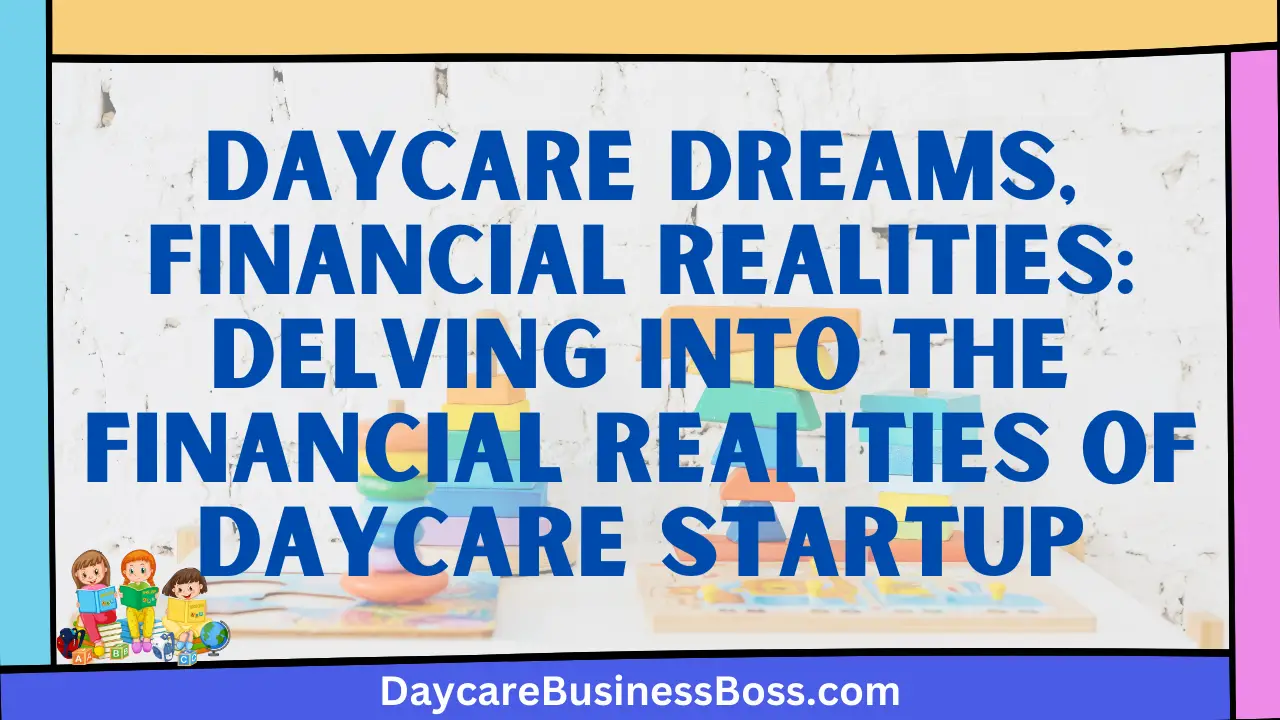As the need for high-quality childcare grows, the thought of opening a daycare center might be an intriguing entrepreneurial venture. However, beneath the bright playrooms and loving environs lurks a critical issue that will decide the venture’s viability: the cost. The financial landscape of opening a daycare center is complex and varied, with rigorous planning and an awareness of the various expenses involved.
To financially plan for a daycare startup, you should begin by understanding the various costs involved. Home-based setups require between $10,000 and $50,000, while larger centers require between $50,000 and $500,000. These costs encompass licensing, permits, staffing, equipment, and marketing.
In this inquiry into the question, “How much does it cost to start a daycare center?” we will delve into the complexities of startup costs, unraveling the layers of financial commitment required to transform a dream into a fruitful childcare venture.
Understanding the Range of Costs

When commencing on the road to developing a daycare firm, effective financial preparation is critical. The complexities of this activity necessitate a thorough awareness of the many expenditures involved. Those choosing home-based setups, which are known for their cost-effectiveness, must be aware of the financial commitment ranging from $10,000 to $50,000. However, aspiring entrepreneurs considering the development of a larger daycare center must brace themselves for much increased financial requirements, which range from $50,000 to $500,000.
Within these seemingly intimidating figures is a vast array of expenses that, when added together, define the growth of your daycare endeavor. The range of factors covered by these expenses is vast and critical. They include the licensing and legal expenses required to ensure regulatory compliance, which is critical for long-term operations. Infrastructure costs such as child-friendly furnishings, instructional resources, and safety measures are also important. Staff pay and training costs are extremely important because the quality of care is dependent on a well-paid and trained team.
Physical space also accounts for a significant portion of the financial outlay, whether through commercial space lease or home environment modification. Marketing expenses to encourage enrolment and community participation are also budgeted for. The use of technology for streamlined operations and security increases the financial requirements even further.
Read more about: Budgeting for At-Home Childcare: Navigating the World of Daycare Costs
Licensing and Permits
The purchase of necessary licenses and permits is the foundation of your daycare’s financial plan. This fundamental stage is not only a legal requirement, but it is also a critical indication of your daycare’s legitimacy and reliability. Beyond mere technicalities, these permits demonstrate your dedication to adhering to state and local standards, generating a sense of credibility in your community. As you navigate this financial terrain, keep in mind that the fees associated with licensing are subject to a complex interplay of factors, principally your geographic area and the kind of childcare institution.
The financial outlay associated with obtaining these licenses includes a range of expenses that demand careful budgeting. Among these, application costs are the first step, requiring a financial commitment that varies by jurisdiction. Background checks on employees and business owners are an important part of ensuring the safety of the children in your care. Allocating funds for health and safety inspections is also essential, as these examinations confirm your daycare’s adherence to industry-standard rules.
Trying to save money on licenses and permissions can have serious consequences in the long term. Failure to get necessary licenses can result in hefty fines, operational difficulties, and a loss of reputation in the community. As a result, allocating a certain part of your budget to cover these costs is unambiguous.
Staffing
Staffing is a critical component of your daycare’s financial equation, requiring careful consideration. The growth of your childcare business is dependent on the quality of care provided to the children, which is inextricably linked to the competence and dedication of your personnel. As a result, developing a complete financial strategy entails accounting for a wide range of staffing-related costs, with the understanding that these investments provide significant benefits in terms of parental satisfaction and children’s development.
Salaries are a critical component of your staffing budget. Offering competitive pay ensures that you recruit and keep qualified professionals capable of nurturing the children in your care. Similarly, providing benefits such as health insurance, retirement programs, and paid time off increases employee happiness, fosters loyalty, and reduces turnover.
Aside from monetary considerations, spending money for continued staff training and professional development is a wise decision. This investment broadens your team’s skill set by keeping them up to date on the most recent childcare practices, safety regulations, and educational trends. As a result, the children will receive better care, garnering positive feedback from parents and strengthening your daycare’s reputation.
An effective financial strategy recognizes that the benefits of investing in a skilled and inspired workforce are numerous. Skilled personnel fosters a nurturing environment that encourages children’s growth and learning. Contented parents not only increase the appeal of your daycare, but they can also become outspoken advocates in your neighborhood. Word-of-mouth recommendations, which are frequently based on parent satisfaction, can greatly contribute to enrollment expansion and long-term productivity.
Equipment and Supplies

Outfitting your daycare center with the necessary supplies and equipment emerges as a critical aspect of the financial plan. The thread of provisioning runs through the fabric of financial planning, from cribs and toys to educational resources and sanitation necessities. While the list of materials necessary is lengthy, it outlines the essential components of an environment conducive to holistic infant development. It’s tempting to lean toward cost-effective solutions in the pursuit of budgetary restraint. The fundamental truth remains, however, that the quality and safety of the equipment have a direct impact on the well-being of the children entrusted to your care.
Procurement is more than just a transaction; it is an investment in the children’s growth and learning journey. While frugality may entice, it is critical to build an appreciation for the intrinsic value of quality. A non-negotiable guideline is to prioritize equipment that fosters learning, creativity, and safety. While some things may have a higher initial cost, they pay significant returns over time.
Educational resources are the foundation upon which young minds grow. Choosing objects that promote cognitive and sensory development is beneficial. Toys that encourage imaginative and collaborative play, on the other hand, contribute to a lively and engaging environment.
The aspect of safety serves as a lighthouse, guiding equipment selection. Furniture that adheres to safety rules and hygiene goods that protect health should not be sacrificed for financial reasons.
Read more about: Beyond Swings and Slides: The Essential Daycare Playground Checklist
Facility
The acquisition of an adequate facility is a significant financial undertaking in the context of building a larger daycare center. The outlines of this decision extend across aspects such as location, dimensions, and the state of the premises, all of which combine to shape the entire cost. Whether you choose to lease or buy outright, the financial orchestration must include a complex symphony of considerations.
The location, which is frequently referred to as the heartbeat of your daycare’s accessibility, resonates within the financial echelons. It is crucial in forming the first impression for parents and laying the groundwork for future development. The rental or mortgage expenses are influenced by the size of the facility, which is an expression of your desired capacity. A careful assessment of space requirements is essential.
The financial ledger expands to include operational utilities and property maintenance. In initial excitement, overlooking these ongoing costs can result in unexpected fiscal difficulties. Maintenance necessitates thorough planning, emphasizing the dedication to a friendly and secure environment.
Renovations, as a blank canvas for your creative concept, have the power to change the atmosphere. Financial allocation for such efforts requires careful curation, and accommodating desirable modifications while maintaining fiscal discipline.
Most importantly, the integration of these aspects seeks to create an environment that envelops youngsters in warmth and learning. The attraction of the environment is critical in attracting both young learners and their parents. The facility’s design incorporates safety, while a dynamic atmosphere promotes engagement and cognitive growth.
Marketing and Advertising
Navigating the competitive world of daycare services necessitates a deliberate embrace of marketing and advertising, which are essential to growing visibility and ensuring victory. The compass of financial planning points inexorably towards allocation for these endeavors. The melody of your daycare must be crafted through channels that are appealing to both parents and guardians.
A quality website, a digital conduit through which the spirit of your daycare vibrates, is at the heart of this symphony. The financial note designated for website creation unfolds as an investment in the first impression that parents have. It’s your establishment’s proverbial welcome mat, reflecting your dedication to great care and a nurturing environment.
Social media campaigns have a revolutionary impact in the age of digital connectivity. The money spent on these activities becomes the key that unlocks doors to a large audience, boosting engagement and spreading the word about your daycare. Local advertisements in newspapers, magazines, and community bulletins act as compasses, guiding potential customers to your doors.
Developing your daycare’s personality through appealing branding is an investment that goes beyond the bottom line. It’s a lighthouse, a visual reminder of your values and commitment. A distinct logo, a unified color palette, and a consistent tone across all platforms weave a tapestry that leaves an indelible impression.
A distinct value proposition, as represented through your marketing initiatives, becomes the script on which your daycare’s narrative is imprinted. This proposition, built on the pillars of excellent care, safety, and holistic growth, distinguishes you from the competition. These techniques inspire financial caution since they shape a reputation in the community, leading it toward choosing your services.
Contingency Fund

Regardless of how precise your financial plan is, the prospect of unplanned spending lurks as a constant reality. Anchoring your economic plan with the basis of a contingency fund appears as a beacon of wisdom, protecting against the erratic nature of unexpected obstacles. This fund, like a financial sentinel on patrol, can cocoon your daycare venture in a cocoon of preparation.
A contingency fund acts as protection against the unpredictability of corporate operations. It serves as a financial cushion, absorbing the impact of these financial earthquakes, from unanticipated emergencies to unforeseen maintenance. Enrollment changes, like a pendulum swinging at an unpredictable rate, might further destabilize revenue predictions. With its versatility, this fund acts as a buffer against the disruptions that these changes can cause.
This economic haven serves as an example of restraint in action. It alleviates the tension that might accompany the unexpected and adds a sense of steadiness to the entrepreneurial journey. This financial foundation boosts confidence during the early stages of your firm, allowing you to navigate unfamiliar waters.
A financial commitment to a contingency fund is more than just a practical exercise; it is a commitment to resilience. It demonstrates your astute knowledge that business is a voyage through uncharted waters, and readiness is the compass that guides you through the storms. Whether it’s a sudden equipment failure or a brief drop in enrollment, this fund provides the agility to weather the storm while continuing on track.
Read more about: Innovating Childcare: Strategic Business Planning for Nonprofit Daycare Centers
Frequently Asked Questions

What is the normal cost range for launching a daycare?
The costs of starting a daycare vary depending on factors such as the style of setup and the size of the center. Home-based childcare arrangements often cost between $10,000 and $50,000. Larger daycare centers, on the other hand, which provide more complete facilities and services, may necessitate an expenditure ranging from $50,000 to $500,000. These expenses include things like licensing, permits, staffing, equipment, marketing, and contingencies.
How crucial are proper licensing and permits in childcare starting financial planning?
Obtaining the necessary licenses and permits is critical for a daycare startup’s profitability and legality. These legal criteria ensure not only that you comply with local and state rules, but also that you develop confidence and credibility with parents and guardians. The cost of licensing and permits varies greatly depending on your location and the type of daycare you plan to open. It is critical to budget for these expenses to minimize future legal concerns and build a firm basis for your organization.
Why is establishing a contingency fund so important in the financial planning process?
A contingency reserve is a vital component of daycare starting financial strategy. While you may precisely prepare your budget, unanticipated expenses such as emergency repairs, enrollment variations, or unforeseen operational issues might occur at any time. Having a contingency fund in place guarantees that your daycare can handle these unforeseen financial pressures without jeopardizing the quality of care or the viability of your business. It’s a preventative measure to provide financial stability and peace of mind during your startup’s journey.
To learn more on how to start your own daycare checkout my startup documents here.
The information provided by DaycareBusinessBoss.com (“The Site”) is for general informational purposes only. All information on the Site is provided in good faith, however, we make no representation or warranty of any kind, express or implied, regarding the accuracy, adequacy, validity, reliability, availability or completeness of any information on the Site. Under no circumstance shall we have any liability to you for any loss or damage of any kind incurred as a result of the use of the Site or Reliance on any information provided on the Site. Your use of the Site and your reliance on any information on the Site is solely at your own risk.
This blog post is for educational purposes only and does not constitute legal advice. Please consult a legal expert to address your specific needs. Terms and Conditions. (https://daycarebusinessboss.com/terms-conditions/)

Meet Shawn Chun: Entrepreneur and Childcare Business Fan.
I’m a happy individual who happens to be an entrepreneur. I have owned several types of businesses in my life from a coffee shop to an import and export business to an online review business plus a few more and now I create online daycare business resources for those interested in starting new ventures. It’s demanding work but I love it. I do it for those passionate about their business and their goals. That’s why when I meet a childcare business owner, I see myself. I know how hard the struggle is to retain clients, find good employees and keep the business growing all while trying to stay competitive.
That’s why I created Daycare Business Boss: I want to help childcare business owners like you build a thriving business that brings you endless joy and supports your ideal lifestyle.


